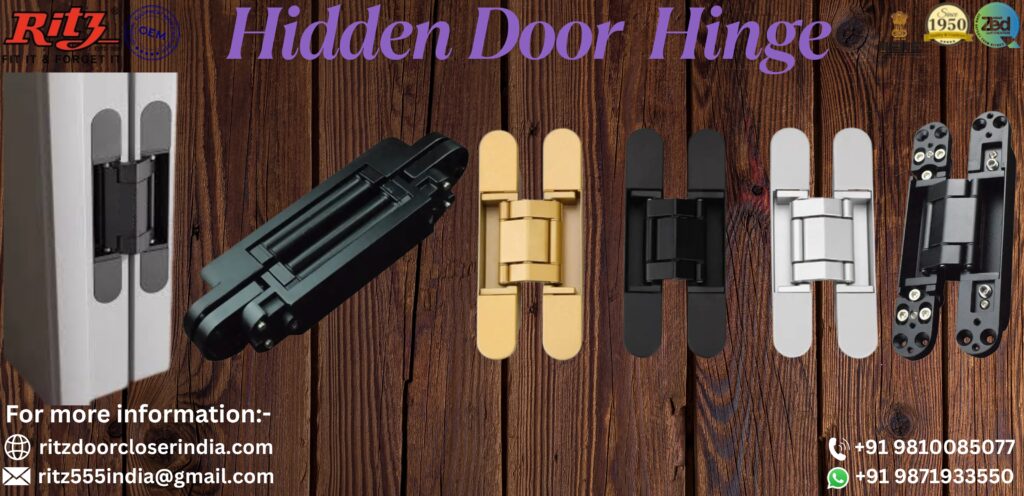
Hidden Door Hinges
In today’s world of modern architecture and interior design, clean lines and minimalism are more than just trends — they’re defining features. One element that helps achieve this look without sacrificing function is the hidden door hinge. Whether you’re designing a high-end home, a contemporary office, or a secret room, hidden hinges are a subtle but powerful upgrade.
This guide will walk you through everything you need to know about hidden door hinges: what they are, how they work, their benefits, and how to choose the right one for your project.
What Are Hidden Door Hinges
A hidden door hinge, also known as a concealed hinge or invisible hinge, is a type of door hinge that is completely hidden when the door is closed. Unlike traditional exposed hinges that stick out on the side of a door, hidden hinges are mounted inside the door and frame.
When installed, they are entirely invisible from the outside. This creates a smooth, uninterrupted appearance — perfect for sleek, modern spaces or hidden entryways.
Why Choose Hidden Hinges?
There are several reasons why homeowners, architects, and interior designers are turning to hidden hinges. Here are the biggest benefits:
1. Clean and Modern Look
One of the top reasons to choose hidden hinges is aesthetic. Since the hinges are completely concealed when the door is closed, you get a flush surface with no visual distractions. This is especially valuable in high-end homes or commercial buildings where design matters.
2. Security
Hidden hinges add an extra layer of security. Since the hinge mechanism isn’t exposed, it’s much harder for intruders to tamper with the door or remove it. This is particularly useful for safes, panic rooms, or hidden storage areas.
3. Smooth Operation
Good-quality hidden hinges offer smooth, quiet, and consistent movement. Many models are designed to open up to 180 degrees, offering wide, unobstructed access — perfect for large entryways or closet doors.
4. Protection Against Damage
Traditional hinges can snag on clothing or get scratched and dirty over time. Hidden hinges are protected within the door structure, meaning they’re less likely to wear out from external contact or environmental exposure.
Common Uses of Hidden Hinges
Hidden hinges are versatile and can be used in many residential or commercial settings. Here are some popular applications:
1. Hidden Rooms or Secret Doors
Want a bookcase that swings open to reveal a hidden study or a wine cellar? Hidden hinges are key. When paired with flush doors and hidden handles, they can create fully camouflaged entryways.
2. Minimalist Interiors
Many modern homes favor sleek surfaces and flat panels. Hidden hinges help create a minimal, no-hardware look that blends seamlessly into walls or cabinetry.
3. High-End Offices and Retail Stores
Luxury environments often use hidden hinges to maintain a professional and polished appearance. Boardrooms, private offices, and storage areas can all benefit from concealed door hardware.
4. Flush or Frameless Doors
In flush designs, the door is perfectly level with the surrounding wall. Hidden hinges are often the only hinge type that can make this kind of design possible.
How to Choose the Right Hidden Hinge
Here are a few things to consider when picking the right hinge:
1. Weight of the Door
Hidden hinges have weight limits. Heavier doors, especially solid wood ones, need heavy-duty hinges or multiple hinges to distribute the load evenly. Always check the weight rating of the hinge.
2. Material and Finish
Hidden hinges are often made from strong materials like stainless steel, brass, or zinc alloy for durability. Choose a rust-resistant finish if your door will be in humid or high-traffic environments.
3. Installation Requirements
Some hinges require precise mortising and professional tools. If you’re installing them on your own, look for models that are easier to fit and adjust.
4. Door Opening Angle
Not all hidden hinges open the same amount. Some offer 90°, 120°, or a full 180° opening. Choose based on how wide you need the door to swing.
Installation Tips
Installing hidden hinges requires more planning and accuracy than standard hinges. Here are some tips:
- Measure Carefully: Accuracy is key when marking mortises for hidden hinges.
- Use the Right Tools: A router, drill press, or mortising jig can help make clean and exact cuts.
- Get Help: Large or heavy doors may require a second pair of hands during installation.
- Follow Manufacturer’s Instructions: Each hinge model is different, so always read the guide.
Maintenance and Care
The beauty of hidden hinges is they don’t need much attention, but regular maintenance will help them last longer:
- Lubricate Annually: A drop of oil in the moving parts can prevent squeaking and wear.
- Clean Dust and Debris: Hidden hinges can still collect dust inside the mortise pocket.
- Check Alignment: Occasionally tighten screws or make minor adjustments if the door begins to sag.
Final Thoughts
Hidden door hinges are a small but powerful feature that can transform the look and feel of any space. Whether you’re building a secret room, redesigning a modern home, or just upgrading your closet doors, concealed hinges bring elegance, functionality, and a touch of sophistication.
They’re not just for luxury homes or Hollywood-style secret doors. With the right tools and planning, hidden hinges are accessible for all kinds of projects — from high-end interior design to clever DIY upgrades.

